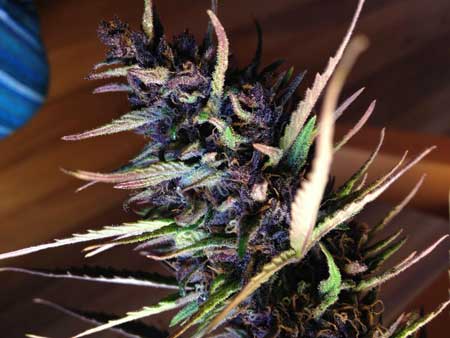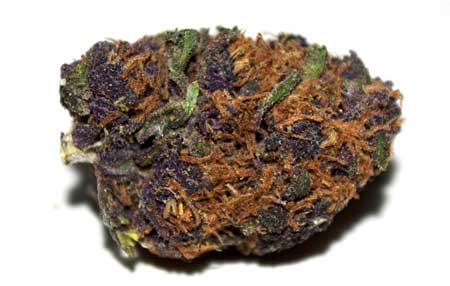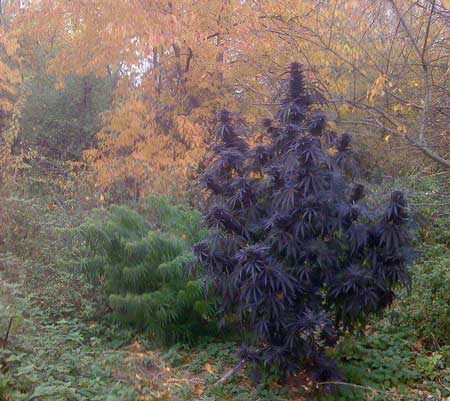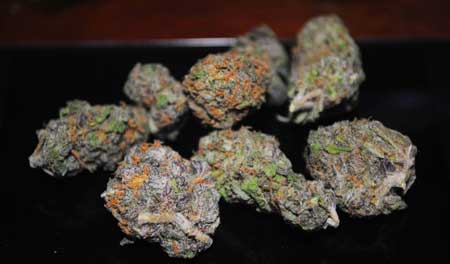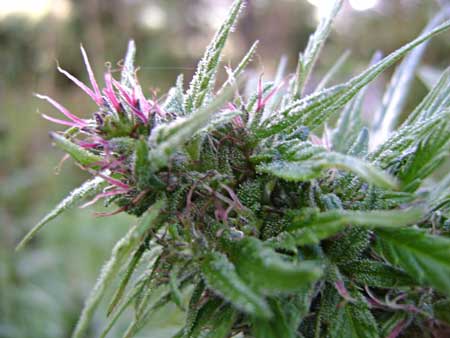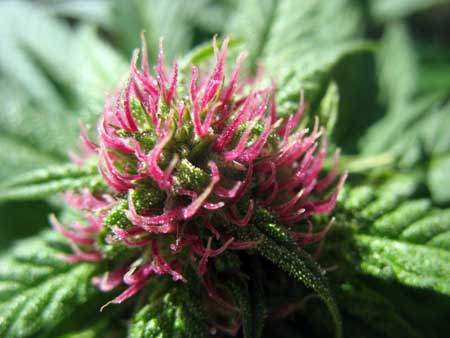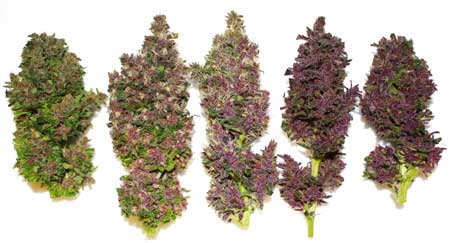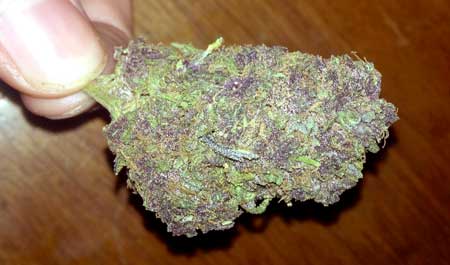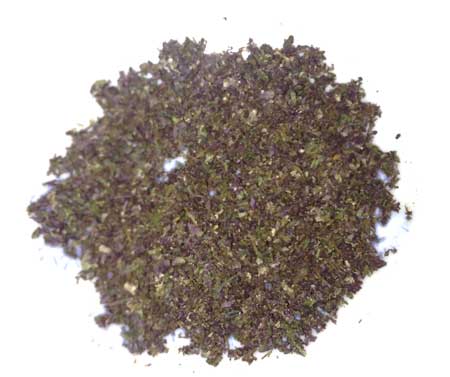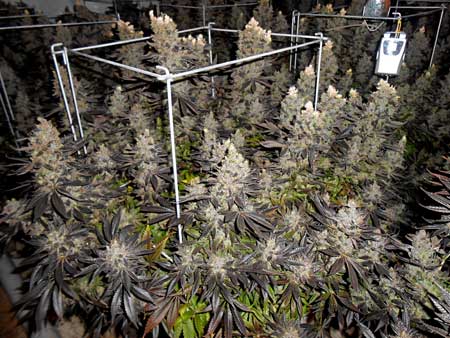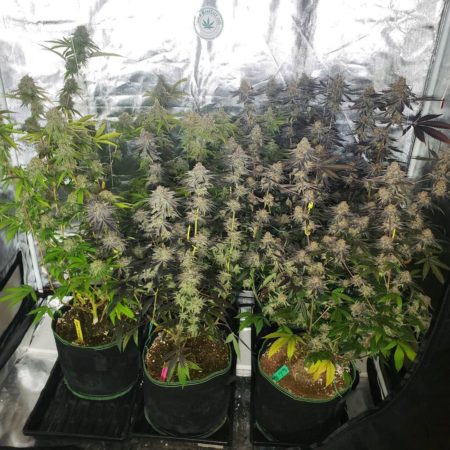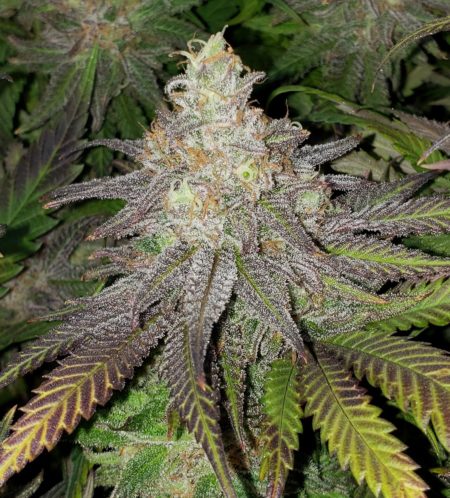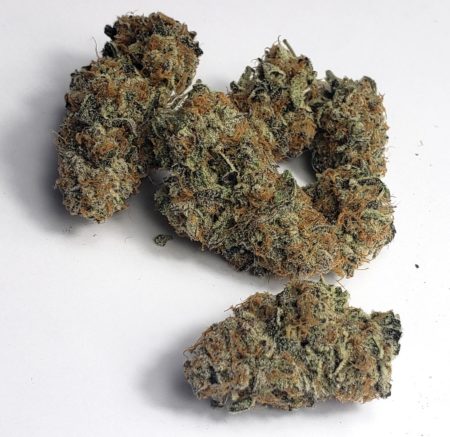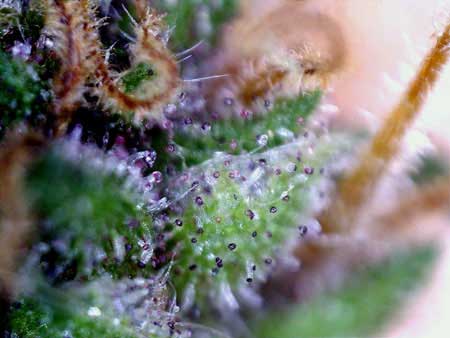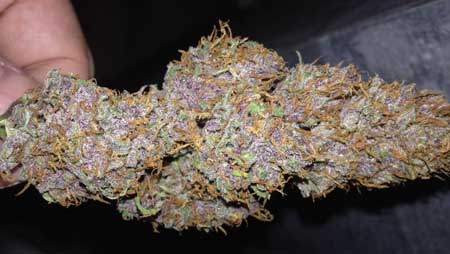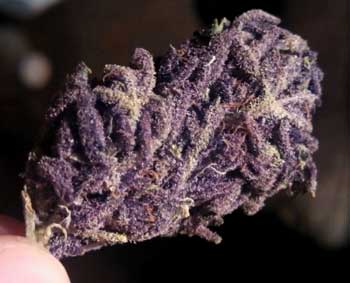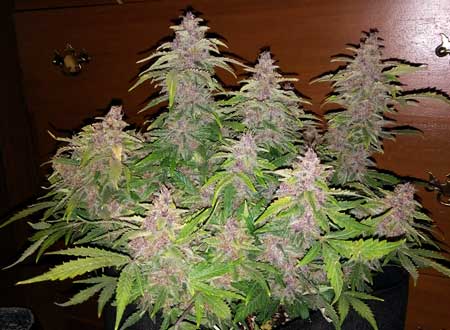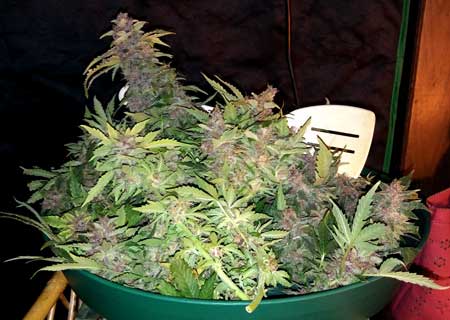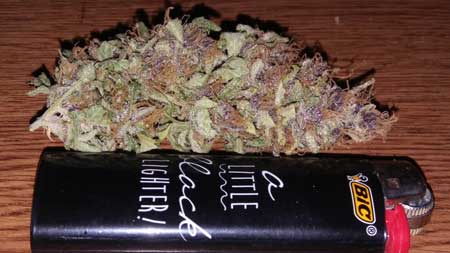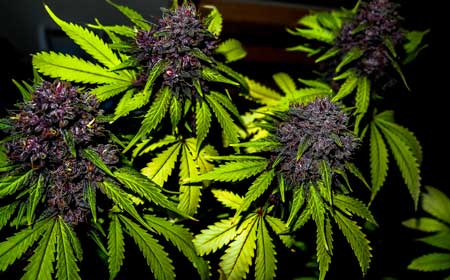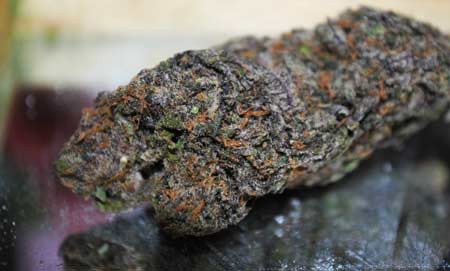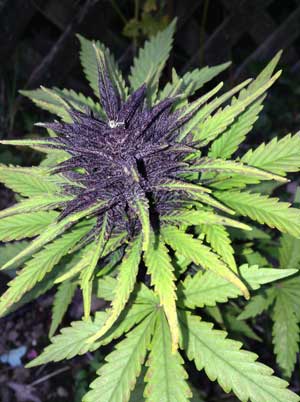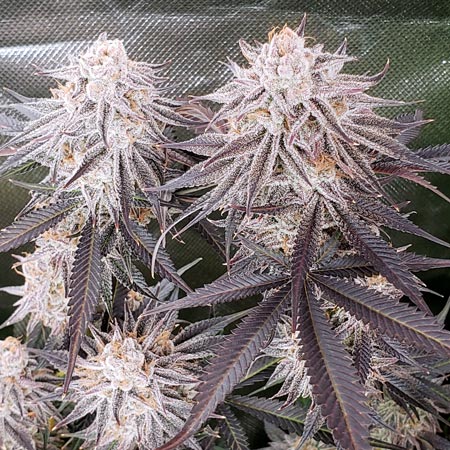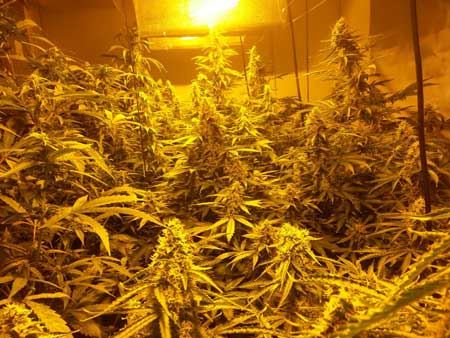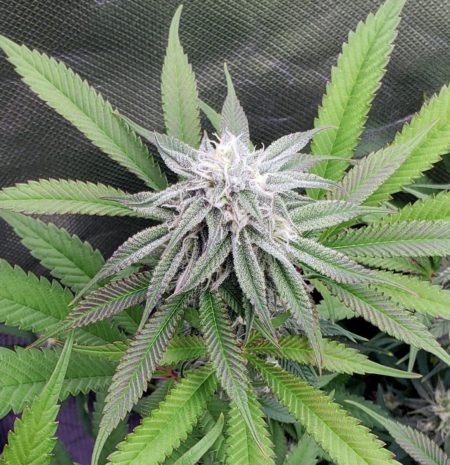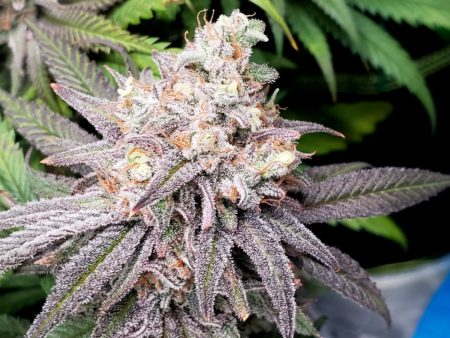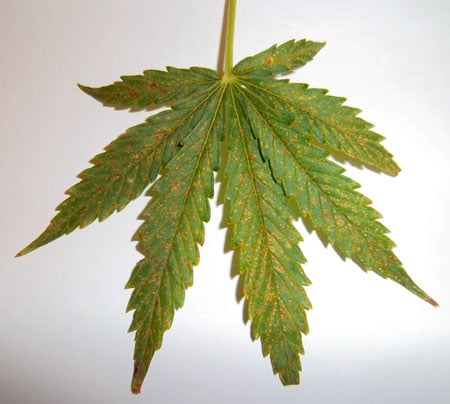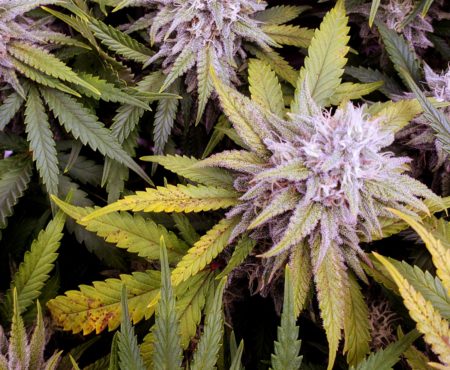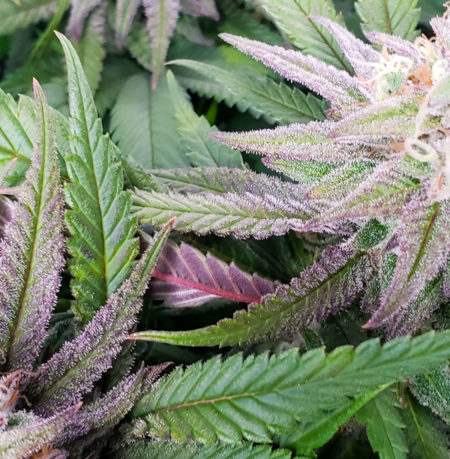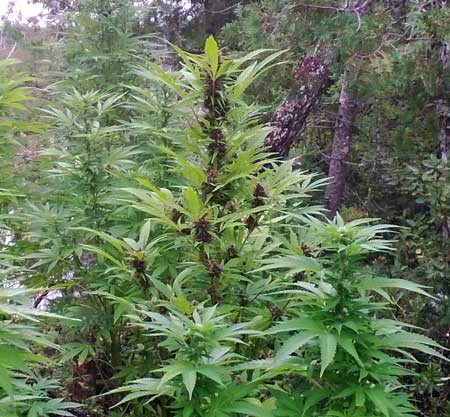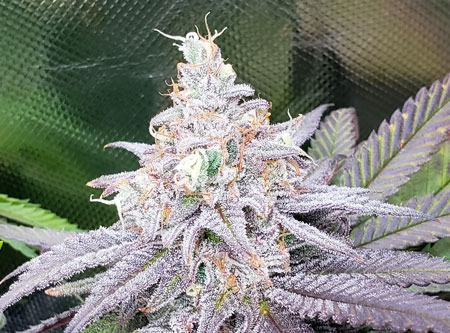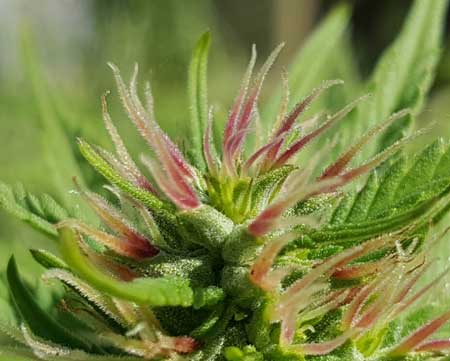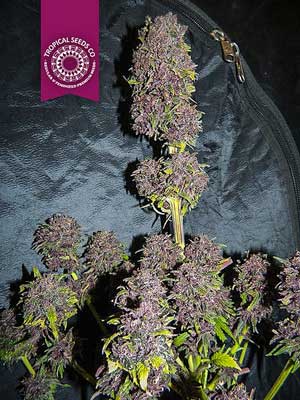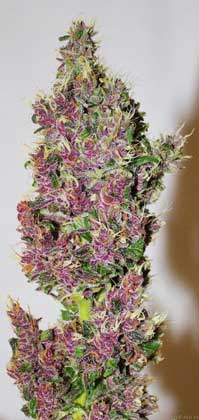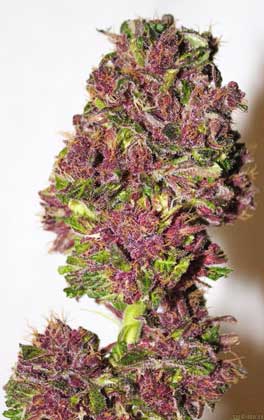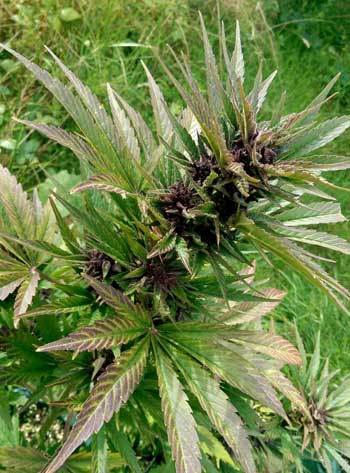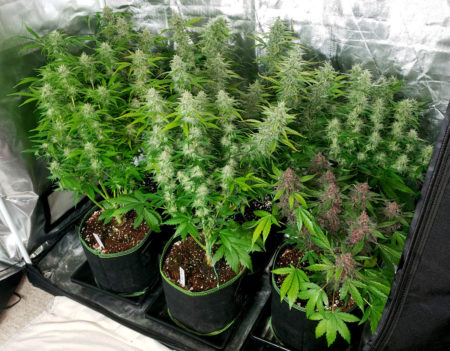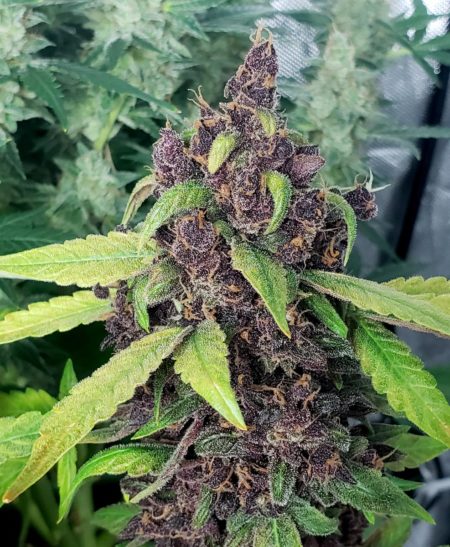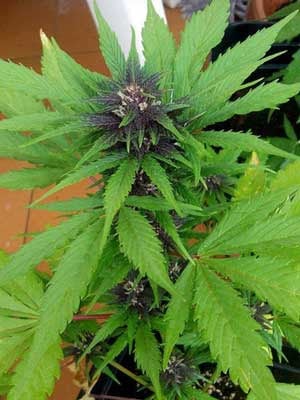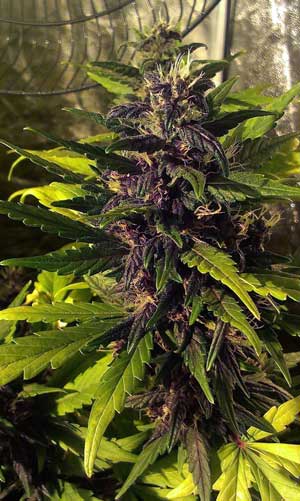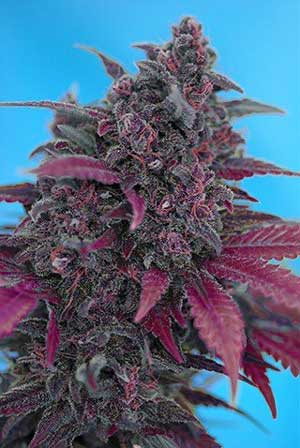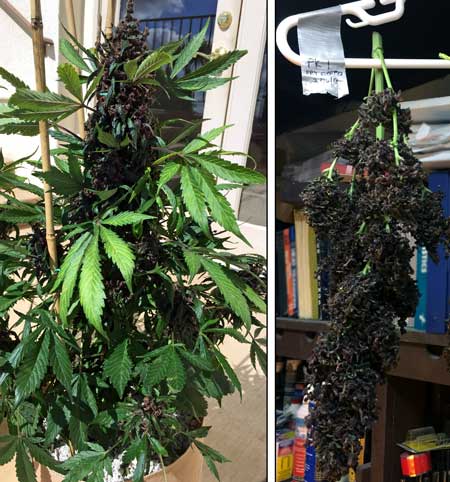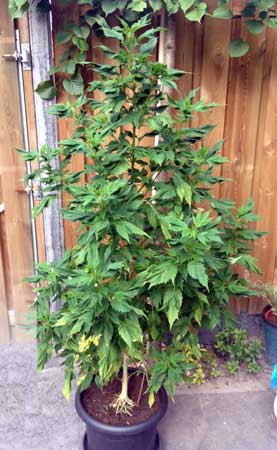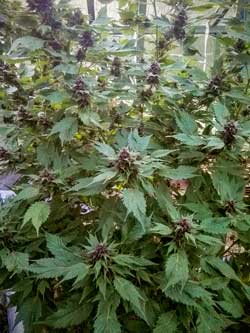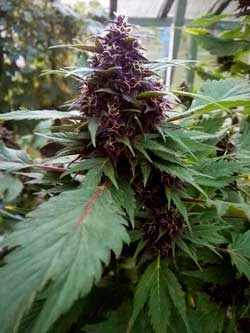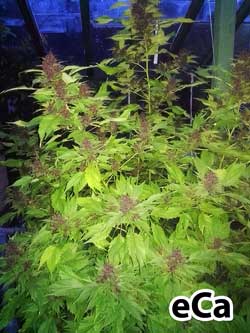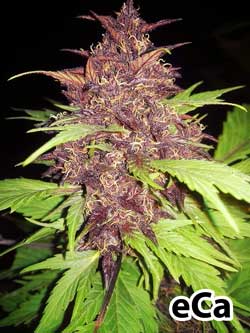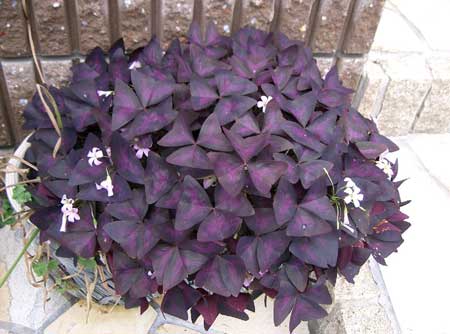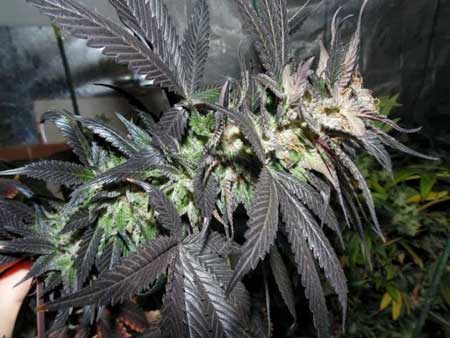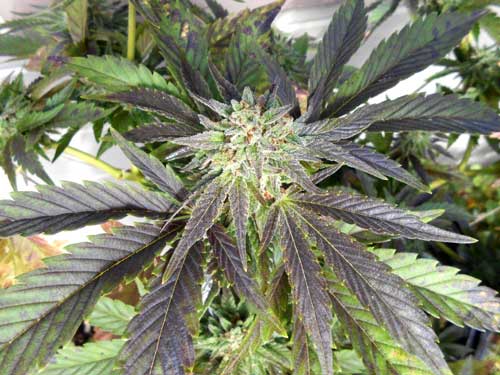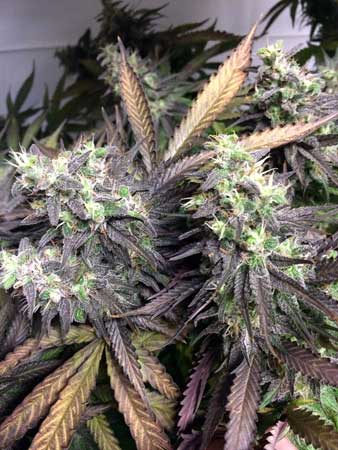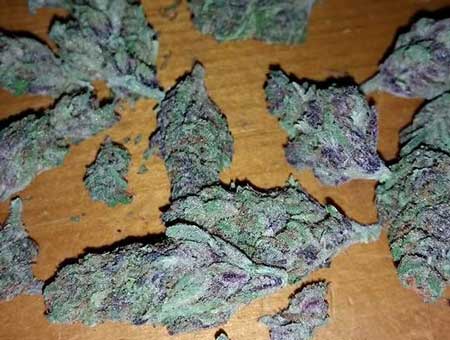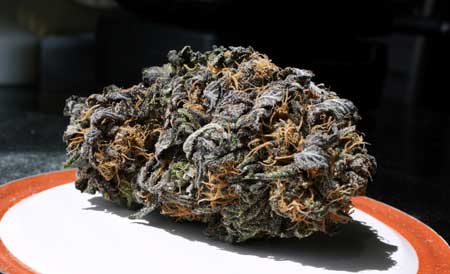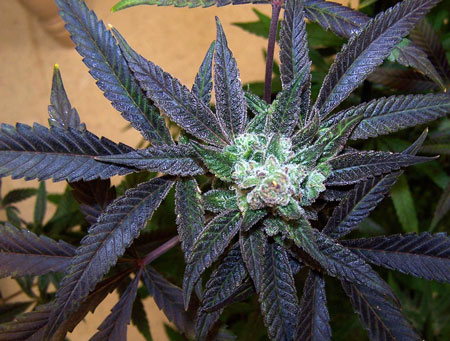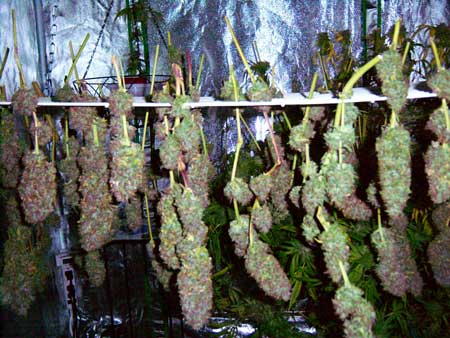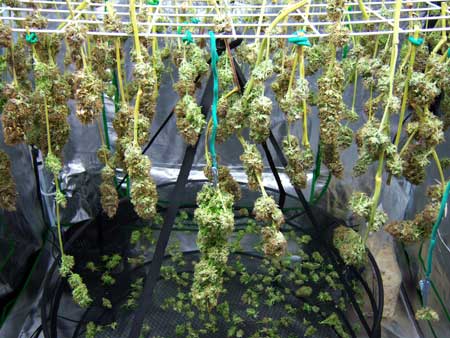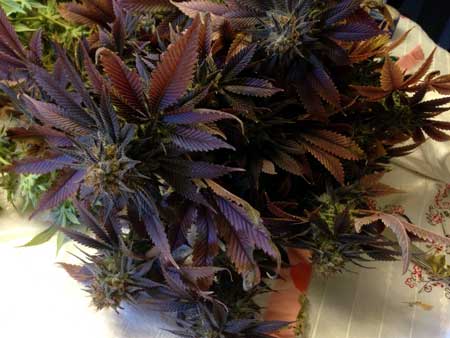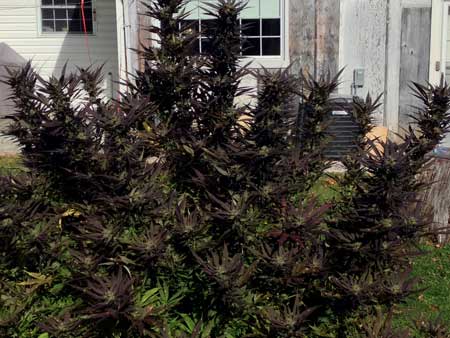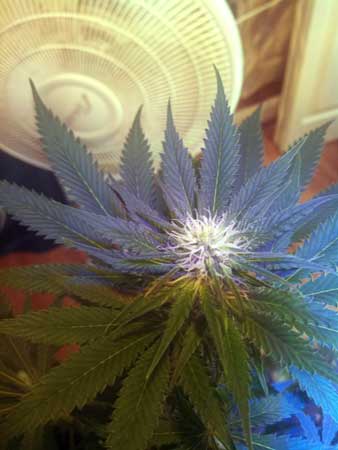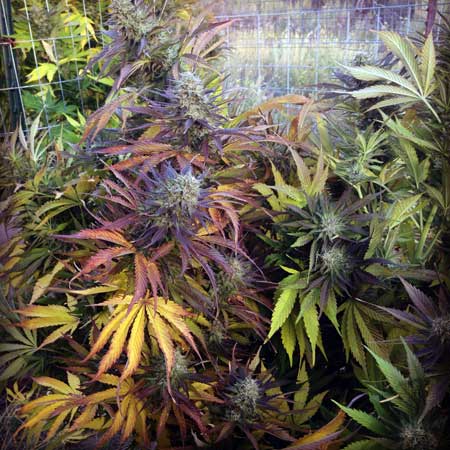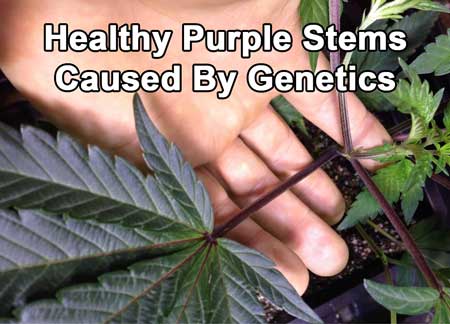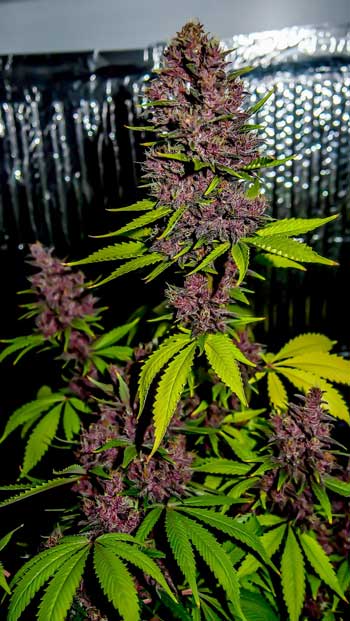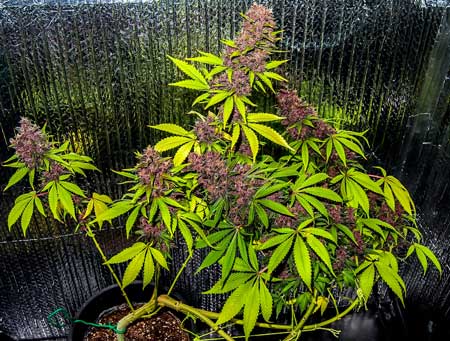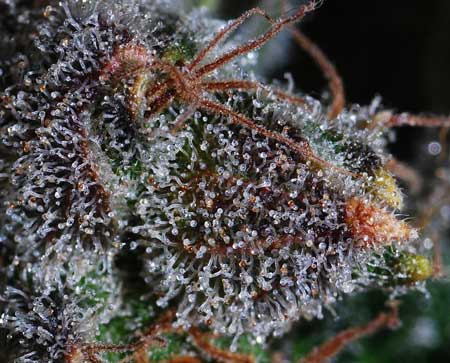by Nebula Haze
Table of Contents
4 “Parts” of Cannabis Plants Can Turn Colors (Buds, Pistils, Leaves & Trichomes)
How to Maximize Color & Genetics
- Start with Colorful Genetics (this is crucial – choose a consistent dark purple strain for the most dramatic colors after drying)
- Warm Days & Cool Nights (temperature difference day and night encourages pink/purple coloring)
- Use the Right Grow Light (strong direct light helps, and certain LEDs tend to bring out colors)
- PH at the Roots (low pH can encourage purpling in some strains though it’s actually a nutrient deficiency so use with caution)
Why Do Leaves and Buds Turn Purple?
Would you like to grow colorful cannabis buds? You may have seen marijuana buds that are pink, purple, red, orange, or possibly even blue! But how do you grow colorful buds at home?
If you want to grow buds that are pink, red, or purple, you must choose the right genetics
The tendency to turn colors is greatly affected by strain/genetics, so you can’t force any plant to produce colorful buds. However, you can purchase seeds of strains that naturally turn vibrant colors, and there are tricks to maximize their genetics and bring out extra colors on your buds.
You cannot produce buds this purple without a strain that has been bred to makes purple buds. There are tricks to maximize the natural color of your genetics, but you have to start with the right genes
4 Different “Parts” of Cannabis Can Become Colorful
When people are talking about “colorful” buds, most people imagine brightly colored buds in their hands. But there are actually different parts of cannabis plants that can display non-green colors, and sometimes people will lump all them all together. Each one is a little different from each other, and some have a significant effect on the final looks of your bud, while others don’t make much difference.
Many different parts of a cannabis plant can turn purple, including the whole plant!
The parts of the plant that can become colorful are…
- Pistils (Hairs) – some of the color remains after drying/curing
- Calyxes (Buds Themselves) – very strong effect on final color
- Leaves – relatively small effect on final bud color since many are removed by trimming
- Trichomes – small effect on final color
Buds are made up of different parts and are usually more than one color
Colorful Pistils / Hairs
Most growers want the buds themselves to appear colorful, so the color stays even after the buds are dried and cured.
There are two parts of the buds that can turn color. One part is the pistils/hairs that stick out. There are several strains where the pistils turn pink or purple.
Sometimes just the pistils/hairs turn pink or purple, while the leaves and buds may still be green.
When buds are dried, they retain some of their pistil color, but you will still be able to see the color coming through underneath.
Colorful Calyxes / Bracts (Buds Themselves)
“Calyxes” are what make the buds themselves (some growers call them “bracts”). Cannabis “buds” are actually made of hundreds of calyxes stacked on top of each other, and some or all of them may become colors other than green.
This fantastic picture shows how the overall appearance of buds changes with the ratio of colorful vs. green calyxes.
Nearly all Smooth Smoke buds (by Tropical Seeds) produce at least a few pink calyxes here and there, and some plants in the right conditions can produce buds where almost every calyx is a deep purple.
Calyxes are what give the most color to your buds. Even a few purple calyxes can give the buds an overall purple tint, and when you break open the buds there will be some pieces that are completely purple.
This nug contains several purple calyxes.
After being ground up, you can see the purple pieces distributed throughout. The higher the percentage of purple calyxes, the more vibrant your final bud color will be.
Colorful Leaves – Sometimes It’s Not the Buds That Turn Color!
With some strains, the leaves may turn purple while the buds stay mostly green. This can make for absolutely gorgeous plants, but since leaves mostly get trimmed off after harvest, usually, a lot of the purple will no longer be as visible on the buds after the trimming process.
For some strains, the leaves may turn purple while the buds stay green. This often happens after the plant gets exposed to chilly night temperatures (but not always). Cannabis leaves exposed to direct light (especially LED grow lights) are most likely to turn purple, while leaves in the shade usually stay green. Low pH at the roots can trigger a nutrient deficiency that makes leaves appear purple on some strains, while the leaves of other strains get brown spots from low pH.
Strong LED grow lights can turn leaves purple on some strains, like this clone of Girl Scout Cookies. When this happens, leaves in the shade often stay green. The purple is essentially a “tan” to protect the leaves.
However, many strains turn yellow in response to too much light, like a human that burns instead of gets a tan in the sun. Notice how some plants in this tent turned purple due to the strong LED grow light, while other plants turned yellow. The only difference was genetics.
Although the leaves have turned purple, the buds themselves may be mostly green.
Only the tops of buds exposed to direct light have any purple left after trimming off all the leaves. Trimming removes a lot of the purple coloring. You can still see some hints of purple but they’re not really “purple” buds.
Why Do Cannabis Leaves Turn Purple?
Colorful Trichomes
In general, cannabis trichomes go from clear (not ready) to white (highest THC) to amber/yellow (more of a mellow effect) before they eventually wither and die. These color changes are often used to determine the best time to harvest cannabis.
However, sometimes, trichomes can turn purple or pink, making it difficult to know when to harvest. In that case, you want to also look at the pistils to determine the best harvest time!
Purple or pink trichomes can make it tough to know when to harvest, but they’re exotic and beautiful. The color of trichomes may leave a slight tint on the buds after they’ve been dried and cured, but the bud color underneath will be the dominant color.
Now that you know all the parts of the plant that can turn green, let’s move on to growing pink and purple buds at home.
How to Maximize Color and Genetics
Before you do anything else, you need to begin with the right genetics. If the genes of your plant don’t make colorful buds, there’s nothing you can do! So, you must start with a colorful strain to get the best results with maximizing color.
- Choose Colorful Strain (Most important!)
- Choose Strain that Produces Very Dark Colors (if you want buds to maintain color after being harvested and dried)
- Temperature – Warm days & cool nights
- Bright Light – Strong light levels can help bring out color, especially LEDs
- PH at the Roots – Some strains may express colors at lower pH ranges
Choose Strains with Brightly Colored Buds and Pistils If Possible – This maximizes the overall colorful appearance of your buds.
For the most significant final effect on your dried and cured buds, you want to choose a strain where as many parts of the plant as possible are colorful. So ideally, you want buds where the pistils and calyxes (which make up most of the final color) are both vividly colored. If the leaves and trichomes are also colorful, that will improve the effect even further.
In this case, the buds are purple, but the pistils are orange.
To maximize the final color, you want to choose a strain with brightly colored buds and pistils. For example, this bud has purple calyxes, mostly purple pistils, and even some purple leaves. This combination makes the entire bud appear bright purple.
Choose Deep Purple Buds for Maximum Color After Drying/Curing – Deeply colored buds (sometimes called “black” strains) tend to be the most vibrant after drying/curing.
To produce the most colorful buds, you need to make sure the color goes all the way through the buds, and ideally, also through all the surrounding leaves. This level of color-penetration is most likely to happen with intensely dark colored buds. Buds that are paler in color tend to lose a lot of their vibrancy in the post-harvest processing.
These buds were mostly pink at harvest, but the color is relatively pale and muted
With this strain, all the leaves stayed green. Only the buds became colorful
After they’re trimmed and dried, the pink color has become more subtle.
You will “keep” the most color after drying/curing by choosing strains that are dark purple through and through, from buds to pistils to leaves if at all possible. Deeply colored buds keep more of their color after drying and curing than pale purple or pink buds.
These buds were deep purple at harvest…
When buds are darkly colored, they tend to keep more color after being dried and trimmed.
Note: Your buds will naturally lose some of their overall vibrancy and color during the drying/curing process (but not any of their potency!). That’s why you will likely never run into neon purple buds that have already been dried and cured for 2+ weeks. Even green buds go from being bright green to a more muted green color by the time they’ve cured for a few weeks. When you see very brightly colored buds, it almost always means the buds are still relatively fresh.
Although color is determined primarily by genetics, there are a few things you can do to help your plant express its natural colors…
Temperature – Some Strains Express Colors When the Night Temperature is a Few Degrees Cooler than the Day
If you’re growing a strain that turns color, some strains will only show their colors when night temperatures are at least a few degrees cooler than during the day in the flowering stage, especially towards the end. However, some plants don’t react to cool night temperatures, and many strains (like Panama) nearly always turn color no matter what the temperature.
Certain strains like Sangria turn color more often when the temperature is warm during the day as opposed to cool at night. So, it’s always a good idea to aim for nice warm days, and cool, comfortable nights, because that contrast seems to help bring out colors for many strains.
How to Maximize Color with Temperature
- Warm Days (75-80°F / 24-27°C)
- Cool Comfortable Nights (65-70°F / 18-21°C)
Note: Some strains turn color no matter what the temperature. You can contact the breeder and ask if they have advice on how to bring out colors for a particular strain. I’ve found that most breeders will get back to you quickly if you go to their website and ask questions!
Temperature makes a difference! Some strains need contrast between day/night temperatures for their buds to turn colors. For example, these Frisian Dew buds turned bright purple after nights started getting below 70°F (21°C), though that doesn’t always happen with this strain.
Learn How to Control Temperature
Strong, Direct Light may help bring out colors (especially LED grow lights)
In some cases, a plant may produce purple tones in response to intense, direct light (on buds and leaves). This is kind of like the plant getting a “tan” and typically is most pronounced on the parts of the plant that are getting direct light (other parts of the plant tend to stay green). The importance of light levels varies on a strain by strain basis.
LED grow lights tend to bring out purple coloring in some strains. Of all the LEDs I’ve tried, I noticed the most purpling under the Mars Hydro TSL 2000W, Spider Farmer SF-2000, and HLG 35R (hotter than the others but the most purpling).
Strong HPS grow lights (especially 400W and bigger) also can bring out colors when temperatures are under control, but to a lesser extent than LEDs. If you want a grow light that tends to bring out purples, I recommend getting an LED.
The pH at the Roots may affect cannabis bud color expression
Outside the cannabis world, there are a few species of plants with flowers that are known to turn different colors based on the pH at the roots.
For example, the flowers of specific types of hydrangeas can turn blue in very acidic soil but may turn pink if exposed to neutral or only slightly acidic soil (though this type of variation is rare in the plant world).
Yet there have been occasional reports of cannabis strains that produce different bud colors based on the pH at the roots.
I have noticed that some strains (especially ones that tend to turn purple already) will often get much more purple if the pH is low (under 6 pH). However, for some strains, this causes plants to get brown spots (a calcium deficiency) so use this tactic with caution and watch plants closely for brown spots.
Low pH at the roots (under 6 pH) can bring out purples in some strains, specifically strains that are already prone to turn purple. This is what it looks like initially.
Here is that plant a few weeks later
For many (if not most) strains, low pH can cause brown spots and sometimes yellowing, so use this tactic with caution, and it’s probably only good to try it close to harvest in case your plant becomes riddled with brown spots. T
These buds were given low pH early in the flowering stage while buds were still mostly white. It did help bring our purple, but as a result, many of the leaves got deficiencies which reduced yields at harvest. If you try to bring out colors via low pH, make sure to wait until plants are close to harvest so you don’t harm the leaves by accident.
If growing multiple plants of the same strain or from clones, you might consider giving plants different pH ranges to see what effect it has on the final bud color.
Learn more about how pH can affect cannabis color!
Pictures and Examples of Colorful Strains
Here are some pictures of cannabis strains that sometimes grow colorful purple and pink buds.
Photoperiod (Regular) Strains
Frisian Dew
The next two pics are of the strain Frisian Dew, a popular strain by Dutch Passion, who specifically designed the strain for growing outdoors. It is exceptionally hardy, high yielding, and is also mold and pest resistant. About 50% of the time, Frisian Dew buds will turn bright purple instead of green!
The plant in the middle with the dark purple buds is Frisian Dew.
Peyote Gorilla
Peyote Gorilla buds are often purple-tinted with purple leaves, especially when grown under LED grow lights. The effects of this strain are awesome and bud quality is above-average.
Panama
The following plants with pink pistils are from the strain Panama by Ace Seeds.
This is what Panama buds may look like when they’re first growing in. This beautiful pink pistil pic is by trippergreenfeet.
As the Panama buds develop, the pistils and even the buds themselves may intensify their pink color
Smooth Smoke
Smooth Smoke buds (by Tropical Seeds) can become quite colorful, with colors from hints of pink to deep purple!
Auto-Flowering Strains
Learn about auto-flowering strains, which are typically ready to harvest within 3 months from germination, and don’t need a 12/12 light schedule to start flowering (like regular cannabis plants).
Auto Frisian Dew
Auto Frisian Dew by Dutch Passion (this is an auto-flowering version of the original famous marijuana strain) – Unlike the regular Frisian Dew which gets about 50% purple bud plants, the breeder claims only 10% of the plants from this strain produce purple buds. Still, some growers are getting far better odds than that. When purple does appear, the color is incredibly vibrant and spills out onto the nearby leaves!
Auto Pink Kush CBD
This Pink Kush CBD auto consistently turns purple and produces excellent high-CBD, low THC buds.
The bright plant here in the lower right is Auto-Flowering Pink Kush CBD
Closeup of the Pink Kush CBD buds. They looked even brighter in person!
Auto-Flowering Bloody Skunk
Auto Bloody Skunk by Sweet Seeds is a strain famous for its beautiful vibrant color.
Bloody Skunk auto strain consistently produces captivatingly purple buds
Auto-Flowering Dark Devil
Dark Devil Auto is another fabulous auto-flowering strain by Sweet Seeds that turns a gorgeous purple or even a deep red.
This Dark Devil Auto bud turned completely purple from top to bottom.
Purple Kush Auto
Brilliant color on Purple Kush Auto plants! The buds turn almost black after being dried!
Colorful “Duck” Strains (Stealth Leaves)
“Duck” strains are characterized by their oddly shaped leaves. The idea is that the plants look less like cannabis with 3-finger leaves. The bright colored buds also help make them look less like cannabis.
Frisian Duck
One of the most popular variations of the Ducksfoot (Ducksfeet?) strains is called Frisian Duck. This strain thrives outdoors and grows with the traditional stealthy leaves. This strain also often makes bright, beautiful purple buds (with cold enough temperatures) that have a fresh scent that is sometimes even a little fruity.
Frisian Duck plants react well to growing in a living soil that’s been composted and amended with slow-release organic ingredients.
This is a Frisian Duck plant in the vegetative stage.
This Frisian Duck plant was grown outdoors in a greenhouse. More than half of Frisian Duck plants grow bright purple buds!
Frisian Duck is based on the famous Frisian Dew strain which also produces purple buds and has been bred for generations specifically for growing outdoors. The Frisian genes thrive under sunlight, and buds are resistant to bugs and mold!
This Frisian Duck plant is just about ready to harvest!
However, even with stealthy strains, be aware that they still smell like cannabis in the budding stage!
Why Do Cannabis Leaves and Buds Turn Purple?
Sometimes you’ll see purple leaves because of a nutrient deficiency, but oftentimes purple leaves are actually caused by natural plant processes.
There are many species of plants that make purple leaves. The leaves appear purple due to high levels of a purple pigment called anthocyanin. Anthocyanin may act as a sunscreen for plant leaves because it protects against damage caused by UV-B rays. Anthocyanin is also known to help protect against cold or heat stress on the cellular level.
It’s not just cannabis plants that grow purple leaves. Here’s an example of a False Shamrock plant, which has glorious purple leaves from top to bottom!
With some cannabis strains, the leaves may turn purple while the buds stay green. Just like with buds, leaves are more likely to turn color when plants get cool night temperatures in the late flowering stage.
The leaves most likely to be affected are the top leaves and other leaves getting direct light. With this purpling, the leaves in the shade of the plant usually stay green.
For some strains, the leaves may turn purple while the buds stay green.
The leaves of this plant turned purple overnight after that plant was exposed to chilly night temperatures.
The leaves exposed to direct light are most likely to turn purple, while leaves in the shade often stay green
In this case, all the leaves that are exposed to the light have turned purple, including the sugar leaves. However, once the leaves are trimmed off, the buds will be mostly green.
Buds may still be purple-tinted from leaves that weren’t completely trimmed off.
If there’s a lot of purple leaves, there may be a lot of color left even after trimming.
Case Study – Super Purple Haze plant
The top leaves of this Super Purple Haze plant have turned a vibrant purple
Here are the buds from that Super Purple Haze plant drying – you can see that the parts of the buds that were exposed to the light have strong hints of purple
A closer look at those buds so you can better see how much bud is purple and how much is green after being trimmed and dried (click for a closeup!)
This cannabis plant has grown vibrant red and purple leaves.
This outdoor cannabis plant has turned purple everywhere it received direct sunlight. Splendid!
Cannabis sometimes has neat mutations, like this two-tone plant where only half the leaves turned purple!
These Swiss Cheese plants by Nirvana exploded with red, pink and purple leaves when it got cool at night right near harvest time, but the buds themselves did not change color. Unfortunately, when just the leaves turn color, the buds themselves will often look mostly green once they’re trimmed. But this beautiful picture lives forever!
Bright purple stems may be a sign of a phosphorus deficiency, but this “symptom” is sometimes actually caused by genetics, just like purple leaves, pistils or buds!
Blue Dream (rare deep purple phenotype)
Blue Dream buds usually don’t turn this deep purple, so if you want to see buds like this you’re better off with a strain that’s bred to always grow dark purple buds. However, the pictures were so beautiful I just had to share!
A closeup of a purple cannabis calyx
Now learn how to improve…

